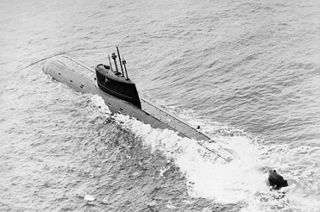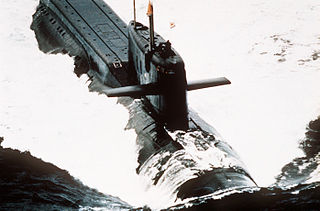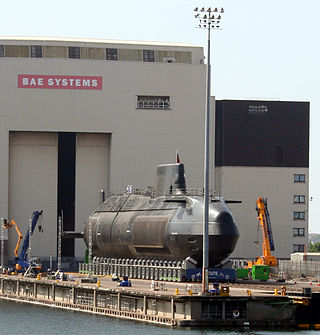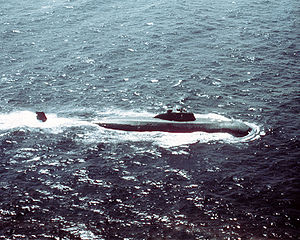
The Oscar class, Soviet designations Project 949 Granit and Project 949A Antey, are a series of nuclear-powered cruise missile submarines designed in the Soviet Union for the Soviet Navy. First built in the 1970s, six remain in service with the Russian Navy. Two other vessels were slated to be modernized since at least 2017 as Project 949AM, to extend their service life and increase combat capabilities but it is unclear whether work continues as of 2023.

The K-278 Komsomolets was the Project-685 Plavnik, nuclear-powered attack submarine of the Soviet Navy; the only submarine of her design class.

The Yankee class, Soviet designations Project 667A Navaga (navaga) and Project 667AU Nalim (burbot), was a series of nuclear-powered ballistic missile submarines built in the Soviet Union for the Soviet Navy. In total, 34 units were built: 24 in Severodvinsk for the Northern Fleet and the remaining 10 in Komsomolsk-on-Amur for the Pacific Fleet. Two Northern Fleet units were later transferred to the Pacific. The lead boat K-137 Leninets received its honorific name on 11 April 1970, two and one half years after being commissioned.

A cruise missile submarine is a submarine that carries and launches cruise missiles as its primary armament. Missiles greatly enhance a vessel's ability to attack surface combatants and strike land targets, and although torpedoes are a more stealthy option, missiles give a much longer stand-off range, as well as the ability to engage multiple targets on different headings at the same time. Many cruise missile submarines retain the capability to deploy nuclear warheads on their missiles, but they are considered distinct from ballistic missile submarines due to the substantial differences between the two weapons systems' characteristics.
The KSShch was a Soviet anti-ship cruise missile design that carried a nuclear warhead. Its GRAU designation is 4K32. It was sometimes referred to as P-1 Strela. It was used in the 1950s and 1960s. The missile's NATO reporting name was SS-N-1Scrubber. It was tested in 1953–1954 on the destroyer Bedovyy (Kildin-class) and entered service in 1955, being deployed on Kildin- and Krupnyy -class ships. It was fired from a heavy rail launcher SM-59, with an armoured hangar. As those ships were retrofitted and modernized between 1966 and 1977, the missiles were removed.

Vepr (K-157) is a Project 971 Shchuka-B class nuclear-powered attack submarine of the Russian Navy. Her keel was laid down on 16 June 1990 by Sevmash. She was launched on 10 December 1994, commissioned on 25 November 1995, and homeported in Gadzhievo. Vepr is armed with four 533 mm torpedo tubes which can use Type 53 torpedoes, RPK-6 or the RPK-2 missiles - older type and Kalibr type armament, naval mines, and four 650 mm torpedo tubes which can use Type 65 torpedoes, or the RPK-7 missile.

A nuclear submarine is a submarine powered by a nuclear reactor, but not necessarily nuclear-armed. Nuclear submarines have considerable performance advantages over "conventional" submarines. Nuclear propulsion, being completely independent of air, frees the submarine from the need to surface frequently, as is necessary for conventional submarines. The large amount of power generated by a nuclear reactor allows nuclear submarines to operate at high speed for long periods, and the long interval between refuelings grants a range virtually unlimited, making the only limits on voyage times being imposed by such factors as the need to restock food or other consumables.

The Akula class, Soviet designation Project 971 Shchuka-B is a series of fourth generation nuclear-powered attack submarines (SSNs) first deployed by the Soviet Navy in 1986. There are four sub-classes or flights of Shchuka-B, consisting of the original seven Project 971 boats, commissioned between 1984 and 1990; six Project 971Is, commissioned between 1991 and 2009; one Project 971U, commissioned in 1995; and one Project 971M, commissioned in 2001. The Russians call all of the submarines Shchuka-B, regardless of modifications.

The Echo class were nuclear cruise missile submarines of the Soviet Navy built during the 1960s. Their Soviet designation was Project 659 for the first five vessels, and Project 675 for the following twenty-nine. Their NATO reporting names were Echo I and Echo II. All were decommissioned by 1994.

The Delta class, Soviet designations Project 667B Murena, Project 667BD Murena-M, Project 667BDR Kalmar, Project 667BDRM Delfin, are a family of nuclear-powered ballistic missile submarines, designed and built in the Soviet Union, which formed the backbone of the Soviet and Russian strategic submarine fleet since their introduction in 1973. They carry nuclear ballistic missiles of the R-29 Vysota family, with the Delta I, Delta II, Delta III and Delta IV classes carrying the R-29/SS-N-8 'Sawfly', R-29D/SS-N-8 'Sawfly', R-29R/SS-N-18 'Stingray' and R-29RM/SS-N-23 'Skiff' respectively.

The Udaloy class, Soviet designation Project 1155 Fregat and Russian designation Project 11551 Fregat-M, are series of anti-submarine guided-missile destroyers built for the Soviet Navy, seven of which are currently in service with the Russian Navy. Twelve ships were built between 1980 and 1990, while the thirteenth ship built to a modified design, known as Udaloy II class, followed in 1999. They complement the Sovremenny-class destroyers in anti-aircraft and anti-surface warfare operations. The codename Udaloy comes from an archaic Russian adjective удалой, meaning daring or bold.

The Sierra class, Soviet designations Project 945 Barrakuda and Project 945A Kondor,, are a series of nuclear-powered attack submarines intended for the Soviet Navy and currently in service with the Russian Navy.

The Project 670 Skat submarine was a nuclear-powered cruise missile submarine built for the Soviet Navy and later operated by the Russian Navy. All Charlie I/II-class submarines are decommissioned. One Charlie-class submarine was used for testing an Oniks missile. Charlie I and its successor Charlie II-class submarines are designed by the Lazurit Central Design Bureau of Gorky.
B-414 Daniil Moskovsky was a Project 671RTM Schuka attack submarine of the Russian Northern Fleet. The submarine was laid down in 1989, launched and commissioned in 1990. It was known as K-414 before renaming in 1992. In 1994 B-414 took part in joint combat service with SSBN Karelia (K-18) of the Delta IV class. In 1996 the submarine was named after Prince Daniil Moskovsky, the youngest son of Alexander Nevsky.

K-114 Tula is a Project 667BDRM Delfin-class nuclear-powered ballistic missile submarine (SSBN). As such, she carries a complement of R-29RM Shtil and R-29RMU Sineva nuclear submarine-launched ballistic missiles (SLBM) as her primary deterrent mission, along with anti-ship missiles and torpedoes, the latter for self-defense. Built in Severodvinsk during the late 1980s, she served with the Soviet Navy before being transferred to the Russian Navy following the dissolution of the Soviet Union. Tula underwent an extensive overhaul during 2000–2004 and was fitted with upgraded Shtil SLBMs, several of which were launched from her during her later operational life. She was sponsored by the city of Tula, and is homeported in Gadzhiyevo.

Razumnyy was a 1135 Burevestnik-class Large Anti-Submarine Ship or 'Krivak' class frigate that served with the Soviet and Russian Navies. Launched on 20 July 1973, the vessel operated as part of the Pacific Fleet, as a dedicated anti-submarine vessel, with an armament built around the Metel Anti-Ship Complex. The vessel undertook a number of tours, visiting the People's Democratic Republic of Yemen and India. The ship was decommissioned on 16 March 1998 and subsequently disarmed ready to be broken up before the end of the year.

Zadornyy was a Project 1135 Burevestnik-class guard ship or Krivak-class frigate that served with the Soviet and Russian Navies. Displacing 3,200 tonnes full load, the vessel was built around the Metel anti-submarine missile system. Zadornyy was launched on 25 March 1979 in Leningrad, the last of the class to be built by the A.A. Zhdanov shipyard, and served with the Northern Fleet. After taking part in exercises Avangard-81, Sever-81 and Okean-83, and cruising as far as Havana, Cuba, the vessel was upgraded between 11 June 1990 and 23 May 1995 with missiles that added anti-ship capability. While serving with the Russian Navy, the ship took part in joint exercises with frigates of the Royal Navy, including a commemoration of the first Arctic convoy of the Second World War with HMS Campbeltown. After more than twenty-five years service, the ship was decommissioned on 3 December 2005.

Doblestnyy was a Project 1135 Burevestnik-class Large Anti-Submarine Ship or Krivak-class frigate. With an armament centred on four Metel missiles, the ship was launched on 22 February 1973 and joined the Northern Fleet of the Soviet Navy as a dedicated anti-submarine vessel. Doblestnyy was designated a Guard Ship from 28 July 1977 in response to a change in emphasis of the navy, and subsequently undertook visits to a number of African nations, including Angola and Ghana. Taken out of service to be repaired and upgraded on 19 June 1991, a lack of funding meant that this was cancelled and instead the vessel was decommissioned. The vessel was sold to be broken up on 18 July 1995.

Razyashchiy was a Project 1135 Burevestnik-class Large Anti-Submarine Ship or Krivak-class frigate of the Soviet Navy. Displacing 3,200 tonnes full load, the vessel was built around the Metel anti-submarine missile system. Launched on 22 July 1974, Razyashchiy joined the Pacific Fleet of the Soviet Navy. While serving in the Arabian Sea, in 1983, Razyashchiy suffered minor hull damage from colliding with the destroyer USS Fife while approaching a US fleet. The ship also undertook visits to Port Louis, Mauritius, and Danang, Vietnam, to, among other objectives, enhance the relationships between these countries and the Soviet Union. In 1991, the vessel was transferred to the newly-formed Russian Navy. After nearly twenty years of service, however, Razyashchiy was in a poor state and so was decommissioned on 29 October 1992 and sold to be broken up on 6 October 1994.





















